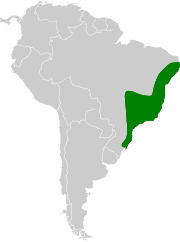Eupetomena
| Eupetomena | |
|---|---|

| |
| Swallow-tailed hummingbird, (Eupetomena macroura) | |
| Scientific classification | |
| Domain: | Eukaryota |
| Kingdom: | Animalia |
| Phylum: | Chordata |
| Class: | Aves |
| Clade: | Strisores |
| Order: | Apodiformes |
| Family: | Trochilidae |
| Tribe: | Trochilini |
| Genus: | Eupetomena Gould, 1853 |
| Type species | |
| Trochilus macroura (swallow-tailed hummingbird) Gmelin, JF, 1788
| |
| Species | |
|
2, see text | |
Eupetomena is a genus in the hummingbird family Trochilidae. It contains two species which are both found in eastern South America.
Taxonomy
[edit]The genus Eupetomena was introduced in 1853 by the English ornithologist John Gould to accommodate a single species, the swallow-tailed hummingbird which therefore becomes the type species.[1] The genus name combines the Ancient Greek eu (εὐ-) meaning "good" and the neuter participle petomena (πετόμενα) meaning "always on the wing" or "flying" (from petomai, πέτομαι, "to fly").[2] Literally, it can mean "the one that flies well, good flyer" (εὐπετόμενα).[3][4]
The genus contains two species:[5]
| Common name | Scientific name and subspecies | Range | Size and ecology | IUCN status and estimated population |
|---|---|---|---|---|
| Swallow-tailed hummingbird | Eupetomena macroura (Gmelin, JF, 1788) Five subspecies
|
Guianas, Bolivia, Peru, Brazil, Paraguay and northeast Argentina
|
Size: Habitat: Diet: |
LC
|
| Sombre hummingbird | Eupetomena cirrochloris (Vieillot, 1818) |
Brazil
|
Size: Habitat: Diet: |
LC
|
The sombre hummingbird was formerly placed in the genus Aphantochroa but based primarily on a molecular phylogenetic study published in 2014, Aphantochroa has been merged into Eupetomena.[5][6][7]
References
[edit]- ^ Gould, John (1853). A Monograph of the Trochilidae, or Family of Humming-Birds. Vol. 2. London: self. Plate 42 and text (Part 6 Plate 1). The 5 volumes were issued in 25 parts between 1849 and 1861. Title pages of all volumes bear the date of 1861.
- ^ Jobling, James A. (2010). The Helm Dictionary of Scientific Bird Names. London: Christopher Helm. p. 152. ISBN 978-1-4081-2501-4.
- ^ "εὐ-", Wiktionary, 2020-10-24, retrieved 2023-04-11
- ^ "πέτομαι", Wiktionary, 2022-12-31, retrieved 2023-04-11
- ^ a b Gill, Frank; Donsker, David; Rasmussen, Pamela, eds. (January 2022). "Hummingbirds". IOC World Bird List Version 12.1. International Ornithologists' Union. Retrieved 13 July 2022.
- ^ McGuire, J.; Witt, C.; Remsen, J.V.; Corl, A.; Rabosky, D.; Altshuler, D.; Dudley, R. (2014). "Molecular phylogenetics and the diversification of hummingbirds". Current Biology. 24 (8): 910–916. Bibcode:2014CBio...24..910M. doi:10.1016/j.cub.2014.03.016. PMID 24704078.
- ^ Stiles, F.G.; Remsen, J.V. Jr.; Mcguire, J.A. (2017). "The generic classification of the Trochilini (Aves: Trochilidae): Reconciling taxonomy with phylogeny". Zootaxa. 4353 (3): 401–424. doi:10.11646/zootaxa.4353.3. PMID 29245495.









